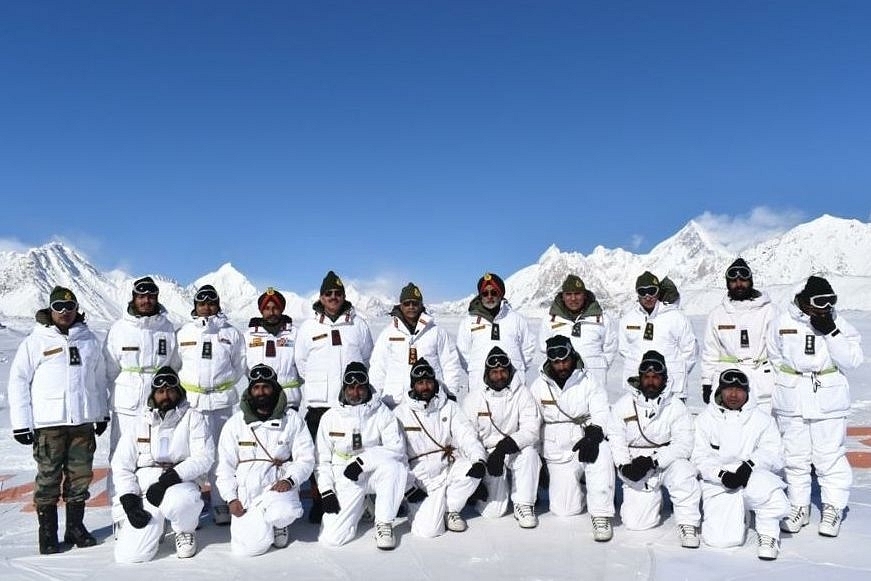Defence
Explained With Numbers: Why The Military Needs Agnipath And Agniveers
- A look at the numbers makes a policy like Agnipath an obvious step for the military.

Former Indian Army Chief General M M Naravane with troops at Siachen glacier (Representative Image)
The Indian military's new Agnipath recreuitment scheme, under which soldiers or Agniveers will be recruited to serve for a period of four years, was launched on 14 June.
The launch had come amid a barrage of criticism from a section of veterans, who believe the scheme would compromise the competence of the armed forces and aspirants, who have argued that the scheme is unjust to them as it does not offer job security and pension.
But many policy makers and military officers insist that both these arguments are incorrect. The new recruitment policy, they argue, would bring down the average age in the military, which would make the integration of technology easier. It would also bring down the spending on pension, and the money saved would be redirected for modernisation.
1) Average age will come down to 26
Currently, the average age of army soldiers is around 32 to 33 years. Only 19 per cent of the personnel below officer’s rank (PBOR) are below the age of 25 years; 27 per cent are in age group of 26 to 30 years, 20 per cent are in the 31-35 years bracket, 19 per cent are in 36-40 years category; a little over 10.2 per cent are in 41-45 years category and 4.4 per cent are in 46-50 years bracket.
According to the Hindustan Times, which reported these numbers, "median age profile of PBOR of Indian Army is higher as compared to other countries particularly China."
With the recruitment of aspirants between 17 and a half to 21 (extended to 23 for this year) years of age, the average age in the PBOR category will come down to 26, giving the Army a more youth profile.
2) Fitter soldier needed for harsh conditions
Along the Line of Actual Control (LAC) with China in the Himalayas, Indian Army soldiers are deployed at elevations between 10,000 feet to 18,500 feet. They survive in inhospitable terrain and remain deployed in the sub-zero temperatures and rarefied atmosphere in areas like the Siachen Glacier, eastern Ladakh and north Sikkim.
In 2021, the base hospital at Leh received 5,349 admissions, out of which at least 560 were brought in with high altitude pulmonary edema, the Hindustan Times reports, adding, "The total number of admissions till May 31 are 1947 out of which as many as 113-115 are down with edema. Frost bites and chill-blains account for over 200 admissions and some 250 personnel were medically evacuated from the battle zone along the LAC."
Having a youthful profile, many veterans have pointed out, would make the Indian Army more suited for operations in these areas.
3) Bring down the burgeoning pension budget
Due to rising pension budget, there's little left to spend on modernisation of the armed forces. The problem has been festering for decades.
The share of pension in the defence budget was at 19 per cent in 2012-13 and grew to 26 per cent in 2019-20. In 2021, the government had allocated Rs 1,33,825 crore or 28 per cent of defence budget for pensions, while the capital outlay was Rs 1,07,233 crore or 23 per cent of defence budget.
The result is that the budget allocation for capital expenditure falls short of resource projection by the armed forces year after year. The Agnipath scheme is perhaps the first time a serious attempt has been made to arrest the slide.
The main aim of the new recruitment policy is to prevent the pensions budget of the military from ballooning further — it makes up almost a quarter of the country's defence budget currently and is, at least in part, the reason behind the meagre modernisation spend.
Introducing ElectionsHQ + 50 Ground Reports Project
The 2024 elections might seem easy to guess, but there are some important questions that shouldn't be missed.
Do freebies still sway voters? Do people prioritise infrastructure when voting? How will Punjab vote?
The answers to these questions provide great insights into where we, as a country, are headed in the years to come.
Swarajya is starting a project with an aim to do 50 solid ground stories and a smart commentary service on WhatsApp, a one-of-a-kind. We'd love your support during this election season.
Click below to contribute.
Latest